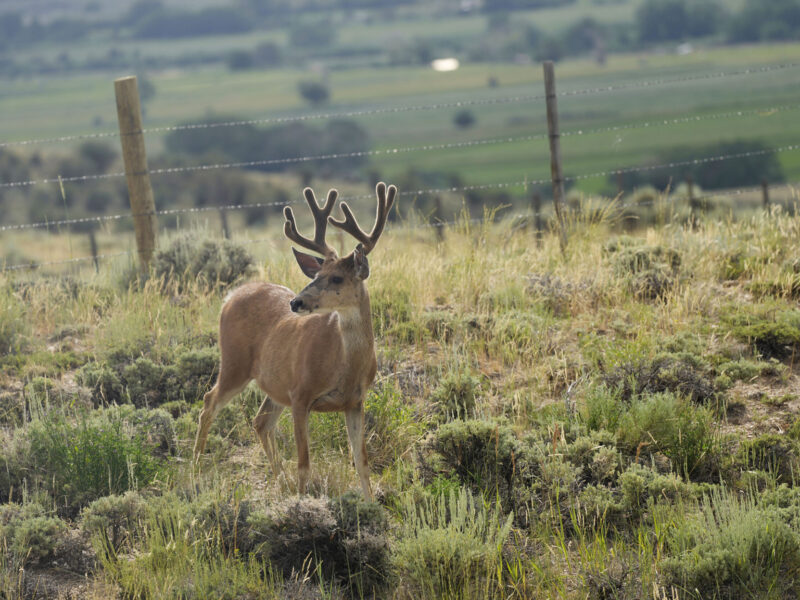Wyoming Hunters Back Deer Tag Cuts for Fall Harvest
State joins several others in limiting takings in response to harsh winter and population declines
- Published In: Other News & Features
- Last Updated: Jun 11, 2023

A mule deer pauses along a state highway Friday, July 22, 2022, near Riverside, Wyoming. In response to a harsh winter, disease and drought, Wyoming and several other Mountain and Great Plains states are cutting the number of mule deer hunting tags they will issue in 2023. Hunters say the reprieve is necessary for the long-term viability of the species. (AP Photo/David Zalubowski)
By K.L. McQuaid
Special to the Wyoming Truth
Wyoming has joined at least seven other Mountain and Northern Great Plains states in trimming the number of mule deer hunting licenses it will issue for this fall.
But rather than decry the cuts, many Wyoming hunters said they support the state’s efforts at conservation – with at least one prominent outfitter claiming not enough is being done to encourage the animals’ future viability.
“What’s going on with mule deer in Wyoming and elsewhere is just heartbreaking,” said Sy Gilliland, founder of SNS Outfitters & Guides, Wyoming’s largest outfitter with about 750,000 acres for hunting leased. “It’s been a challenge to watch their decline in real time. I hoped we wouldn’t get to this point in my lifetime, but everything is stacked against them.”

Wyoming cut the number of mule deer tags allowed this season by 4,410 in response to a severe winter that clipped food supplies and ravaged deer populations in much of the state. Increasingly, mule deer have also been battling drought, Chronic Wasting Disease (CWD) and predators such as mountains lions and black bears for survival.
Although the Wyoming Game & Fish Commission approved the tag cuts stemming from winterkill in mid-April, the issue has gained renewed interest because draw results – in other words, who will be allowed to hunt via a Game & Fish Department drawing –will be announced on June 15.
Along with the tag cuts, the drawing is slated to impact both residents and non-residents alike.
“These conservative cuts reflect the harsh winter we had, and as such I think the [Game & Fish] department responded well in what they put forth,” said Joshua W. D. Coursey, president and CEO of the Muley Fanatic Foundation, a Green River-based hunting and conservation group.
“The state is trying to give somewhat of a reprieve to a species that has really taken it on the chin,” Coursey said of the mule deer. “Mule deer deserve all the help they can get.”
Other states that have announced plans to reduce their deer harvest later this year include Colorado, Nebraska, Utah, North Dakota and Kansas. In all, some 40,300 fewer tags will be issued in the eight states that have unveiled cuts thus far.
North Dakota and Colorado have implemented the greatest reductions by cutting 10,800 and 12,800 deer tags, respectively, from their harvests.
By comparison, both Nebraska and Utah slashed mule deer tags by over 8,000 for 2023 in response to low harvests and the harsh winter weather.

Nebraska, for instance, last year had its lowest buck mule deer harvest in over four decades.
Utah and Colorado each indicated they would issue one-third fewer hunting licenses this year than in 2022.
Wyoming’s estimated mule deer population fell by nearly one-third between 1990 and the mid-2010s, according to state figures.
In 2016, 48,851 deer – the majority of them mule deer – were harvested. Last year, that figure declined to 29,315, Game & Fish Department records show. Of the total, about 60% were mule deer.
Other tag cuts
In response to the years-long declines, the state is taking steps beyond the tag cuts to ensure that mule deer thrive in the future.
Coursey notes that in some areas of Wyoming, the number of days permitted for deer hunting has shrunk by over half this year. In numerous locations, hunting will be allowed only from Oct. 1 through Oct. 6, though for much of the state harvesting will be permitted until Oct. 15.
“It made a lot of sense for them to review the numbers this year and make the cuts where they did,” said Mark Kayser, a Wyoming-based hunter, outdoor writer and photographer. “They want as many female deer as possible to survive because they give birth to the future.”
“And mule deer are not a champion species,” Kayser added. “They have a niche habitat and that’s struggling.”
Mule deer weren’t the only species whose harvest numbers were cut in Wyoming and elsewhere.
Wyoming trimmed by 10,290 the number of antelope tags it will allow, and Colorado elected to shave 3,500 tags in 2023. That state also will eliminate 15,400 elk hunting licenses, the result of the harsh winter.
Wyoming didn’t only trim its numbers, however. In agreeing to the mule deer tag cuts, the Game & Fish Department approved issuing 1,475 additional whitetail deer tags this season.
“Whitetail and mule deer are two different species, and they’ve had different experiences in recent years,” Coursey said. “We’ve seen populations of whitetail that have grown.”
But the new whitetail tags won’t make up economically for the cuts to mule deer, pronghorn and other animals.
For the state, the cuts will mean a loss of revenue in a key area: Wyoming charges residents $42 per hunting license, while non-residents typically pay $374 per tag plus other fees.

Kayser said the impact to tourism could be severe.
“It’s going to really affect people trying to draw a tag, especially non-residents,” he said. “And that trickles down to the guy who runs a motel, to the restaurants that feed hunters to the convenience store selling gas or the shop that sells gear. For a lot of people who aren’t near Yellowstone or one of the other better-known parks, hunting is their tourist season.”
Gilliland said that while many outfitters have been aware of the degradation in mule deer populations for some time and have altered their businesses accordingly, the loss of the animal has had a wide-ranging impact.
“The population is a fraction of what it was 15 years ago,” he said. “We used to take hunters out for mule deer in groups of 80 or 90. Now it’s typically three to five.
“The mule deer decline in the state is so obvious from CWD, predation and other factors that most outfitters have just had to adjust to it,” said Gilliland, the current president of the Wyoming Outfitter & Guides Association. “But at the same time, a lot of us in the outfitting business have been screaming for years about the effects of predation, particularly from mountain lions.”
He said more needs to be done to protect the species, adding he suspects the mule deer population in Wyoming may actually be about half of the figure state officials estimate.
Coursey, too, believes more can be done to enhance the mule deer’s chances of thriving in years to come. One solution, he said, would be to ensure that wildlife crossing corridors remain open.
“I think everyone’s learned from this past winter that a ton of work needs to be done yet to get these deer populations healthy going into future winters,” Coursey said.













